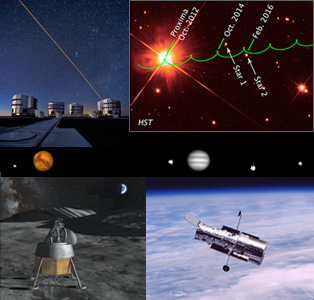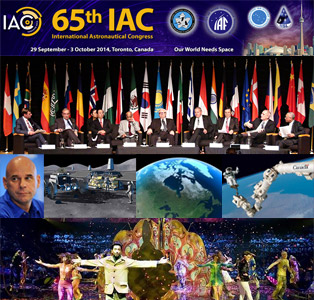HST Astronomy to Be Enhanced by Moon, Mars, Jupiter System Observatories
Hubble Space Telescope (HST) in LEO for over 24 years with its 2.4-meter mirror, and four main instruments observing in near ultraviolet, visible and near infrared spectra, continues to produce some of the most detailed images to date, made possible from its location in Space, outside of Earth atmosphere. HST has the opportunity this month, and in Feb 2016, to take advantage of a rare stellar alignment of red dwarf Proxima Centauri (nearest Star to the Sun – 4.24 LY) when it passes in front of another star. It will attempt to search for small terrestrial-like planets by looking for microlensing effects. ESA Gaia space telescope in LEO and ESO VLT on Cerro Paranal in the Atacama Desert of northern Chile may also be able to make comparable observations / confirm findings. The Large Synoptic Survey Telescope is ready to begin construction also on Cerro Paranal. The team hopes to achieve first light in 2019, first science 2021. A further complement to Space astronomy would be Lunar, Mars and Jupiter system observatories. ILOA is contracting Canadensys Aerospace Corp. to build the ILO-1 space observatory intended for the Moon South Pole to conduct radio and optical astronomy, scientific and commercial communications, and hopes with its affiliated Space Age Publishing Company to pursue Mars and Jupiter system observation and astronomy. (Image Credit: NASA, ESA, K. Sahu, J. Anderson, H. Bond, PSU, M. Dominik, STScI/AURA/UKSTU/AAO, R. Thompson, S. Brunier) |
MONDAY
|

![]() = All times for terrestrial events in local time unless noted.
= All times for terrestrial events in local time unless noted.
![]() = All times for international terrestrial events in local time unless noted.
= All times for international terrestrial events in local time unless noted.
![]() = All times for space events, and…
= All times for space events, and…
![]() = All times for international space / astro events in Hawaii Standard Time unless noted. Add 10 hours to obtain UT (‘Universal Time;’ Greenwich, England).
= All times for international space / astro events in Hawaii Standard Time unless noted. Add 10 hours to obtain UT (‘Universal Time;’ Greenwich, England).
Weekly Planet Watch – Evening Planets: Mars (SW), Saturn (SW); Morning Planets: Jupiter (E).
IAC 2014: Premier Astronautical Event Returns to Canada
|
Continued from…
TUESDAY
WEDNESDAY
|
![]() NET Oct — Large Synoptic Survey Telescope, Cerro Pachón, Chile: Federal construction of LSST to begin this month; team expects to achieve first light in 2019, begin science operations 2021.
NET Oct — Large Synoptic Survey Telescope, Cerro Pachón, Chile: Federal construction of LSST to begin this month; team expects to achieve first light in 2019, begin science operations 2021.
![]() Oct 1 — Deep Space, Main Asteroid Belt: Dawn spacecraft traveling at 64,781 kph with one-way radio signal of ~53 minutes; due to anomalies in ion thrusting will arrive at Ceres Apr 2015, about a month later than originally planned.
Oct 1 — Deep Space, Main Asteroid Belt: Dawn spacecraft traveling at 64,781 kph with one-way radio signal of ~53 minutes; due to anomalies in ion thrusting will arrive at Ceres Apr 2015, about a month later than originally planned.
![]() Oct 1 — International Lunar Observatory Association, International Astronautical Federation, Toronto, Ontario, Canada: Galaxy Forum Canada 2014 – Moon South Pole & Human Missions: Giant Steps into the Galaxy; in conjunction with 65th IAC, 15:00-17:00 local time.
Oct 1 — International Lunar Observatory Association, International Astronautical Federation, Toronto, Ontario, Canada: Galaxy Forum Canada 2014 – Moon South Pole & Human Missions: Giant Steps into the Galaxy; in conjunction with 65th IAC, 15:00-17:00 local time.
![]() Oct 1 — Johnson Space Center, NASA, Houston TX: Mission Operations Support Contract with total potential of US$1.3B goes to Stinger Ghaffarian Technologies Inc of Greenbelt MD to provide mission & flight crew operations support for ISS & future human space exploration.
Oct 1 — Johnson Space Center, NASA, Houston TX: Mission Operations Support Contract with total potential of US$1.3B goes to Stinger Ghaffarian Technologies Inc of Greenbelt MD to provide mission & flight crew operations support for ISS & future human space exploration.
![]() Oct 1 — Silicon Valley Space Center, Mountain View CA: Tech Talk: Planet Labs Dove Spacecraft; presented by Ben Haldeman.
Oct 1 — Silicon Valley Space Center, Mountain View CA: Tech Talk: Planet Labs Dove Spacecraft; presented by Ben Haldeman.
![]() Oct 1 — Moon: At first quarter, 09:32.
Oct 1 — Moon: At first quarter, 09:32.
![]() Oct 1 — Asteroid 2012 SL50: Near-Earth flyby (0.028 AU).
Oct 1 — Asteroid 2012 SL50: Near-Earth flyby (0.028 AU).
![]() Oct 1 — Asteroid 2014 HR178: Near-Earth flyby (0.057 AU).
Oct 1 — Asteroid 2014 HR178: Near-Earth flyby (0.057 AU).
THURSDAY
![]() Oct 2 — Cornell University, Ithaca NY: Lecture: Interpreting Form and Symmetry in Outflows from Geriatric Stars; presented by Bruce Balick from University of Washington.
Oct 2 — Cornell University, Ithaca NY: Lecture: Interpreting Form and Symmetry in Outflows from Geriatric Stars; presented by Bruce Balick from University of Washington.
![]() Oct 2-3 — University of Chile, Santiago, Chile: Workshop: Dynamical Astronomy in Latin-America.
Oct 2-3 — University of Chile, Santiago, Chile: Workshop: Dynamical Astronomy in Latin-America.
FRIDAY
![]() Oct 3 — British Interplanetary Society, London, United Kingdom: Space at 100 – The Next 50 Years in the Human and Robotic Exploration of the Solar System; presented by David Baker; at Bath Royal Literary and Scientific Institute.
Oct 3 — British Interplanetary Society, London, United Kingdom: Space at 100 – The Next 50 Years in the Human and Robotic Exploration of the Solar System; presented by David Baker; at Bath Royal Literary and Scientific Institute.
![]() Oct 3 — Space Center Houston, Houston TX: Lunch with an Astronaut, Leroy Chiao; US$49.95 adult.
Oct 3 — Space Center Houston, Houston TX: Lunch with an Astronaut, Leroy Chiao; US$49.95 adult.
![]() Oct 3 — Asteroid 2011 PT: Near-Earth flyby (0.045 AU).
Oct 3 — Asteroid 2011 PT: Near-Earth flyby (0.045 AU).
SATURDAY
![]() Oct 4 — 10th Observation of Ansari X Prize Award, Nationwide USA: Celebrations to advance / reflect on future human commercial spaceflight & space tourism; US$10M was awarded to Scaled Composites for two SpaceShipOne flights to Space within 14 days; today also marks 57th observation of Sputnik 1 launch.
Oct 4 — 10th Observation of Ansari X Prize Award, Nationwide USA: Celebrations to advance / reflect on future human commercial spaceflight & space tourism; US$10M was awarded to Scaled Composites for two SpaceShipOne flights to Space within 14 days; today also marks 57th observation of Sputnik 1 launch.
![]() Oct 4 — X Prize Foundation, Mojave CA: Ansari X Prize 10th Anniversary luncheon & tour; featuring Peter Diamandis, Richard Branson, Paul Allen, Burt Rutan.
Oct 4 — X Prize Foundation, Mojave CA: Ansari X Prize 10th Anniversary luncheon & tour; featuring Peter Diamandis, Richard Branson, Paul Allen, Burt Rutan.
![]() Oct 4-10 — World Space Week Association, Global: World Space Week 2014.
Oct 4-10 — World Space Week Association, Global: World Space Week 2014.
![]() Oct 4-11 — LPI-JSC Center for Lunar Science and Exploration, NASA Solar System Exploration Research Virtual Institute (SSERVI), Winslow AZ: Meteor Crater Field Camp; students study at Barringer Meteorite Crater to learn about Earth, Moon, asteroids, Mars, other Solar System planetary surfaces.
Oct 4-11 — LPI-JSC Center for Lunar Science and Exploration, NASA Solar System Exploration Research Virtual Institute (SSERVI), Winslow AZ: Meteor Crater Field Camp; students study at Barringer Meteorite Crater to learn about Earth, Moon, asteroids, Mars, other Solar System planetary surfaces.
![]() Oct 4 — Asteroid 2012 HN1: Near-Earth flyby (0.086 AU).
Oct 4 — Asteroid 2012 HN1: Near-Earth flyby (0.086 AU).
SUNDAY
![]() Oct 5-9 — Lowell Observatory, Flagstaff AZ: The Formation and Evolution of Exponential Disks in Galaxies.
Oct 5-9 — Lowell Observatory, Flagstaff AZ: The Formation and Evolution of Exponential Disks in Galaxies.
![]() Oct 5-9 — ESO, ESA, NOAO, Space Telescope Science Institute, Australian Astronomical Observatory, Calgary, Alberta, Canada: 24th Annual Astronomical Data Analysis Software and Systems (ADASS XXIV); at Westin Hotel.
Oct 5-9 — ESO, ESA, NOAO, Space Telescope Science Institute, Australian Astronomical Observatory, Calgary, Alberta, Canada: 24th Annual Astronomical Data Analysis Software and Systems (ADASS XXIV); at Westin Hotel.
![]() Oct 5 — Moon: At perigee (distance 362,063 km), 23:40.
Oct 5 — Moon: At perigee (distance 362,063 km), 23:40.

